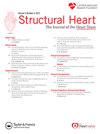Trends in Isolated and Combined Aortic Valve Replacement for Severe Aortic Stenosis in Patients Younger Than 65 Years
IF 2.8
Q3 CARDIAC & CARDIOVASCULAR SYSTEMS
引用次数: 0
Abstract
Background
Recent data demonstrate near equalization in the use of transcatheter aortic valve replacement (TAVR) and isolated bioprosthetic surgical aortic valve replacement (SAVR) in patients aged <65 years for treatment of isolated aortic stenosis (AS). Whether these trends are also seen across the entire spectrum of aortic valve replacement (AVR) procedures (including mechanical SAVR and concomitant procedures) is unknown.
Methods
This retrospective study included patients aged <65 years who underwent AVR for severe AS in the multicenter Northern New England Cardiovascular Disease Group registry between 2015 and 2023. Patients were stratified by approach: TAVR, isolated SAVR, and combined SAVR (SAVR with concomitant procedures).
Results
Of 1254 patients younger than 65 years who underwent AVR, 21.9% underwent TAVR, 39.7% underwent isolated SAVR, and 38.4% underwent combined SAVR. TAVR utilization more than doubled during the study period, with near equalization of TAVR and isolated bioprosthetic SAVR (28.3% and 30.8% of all AVR in 2021-2023, respectively). However, when including mechanical AVR and combined SAVR, TAVR only comprised approximately one-fourth of all AVR procedures. TAVR patients had a significantly higher burden of comorbidities compared with patients receiving isolated or combined SAVR.
Conclusions
In this multicenter study, there is a consistent increase in TAVR use in patients <65 years old with preferential TAVR utilization in patients with higher comorbidities and risk. While approximately 50% of younger patients with isolated AS are receiving TAVR in recent study years, the overall utilization of TAVR in the broader group of patients with both isolated and combined AS remains approximately 25% of the overall AVR cohort.
年龄小于65岁的严重主动脉瓣狭窄患者单独和联合主动脉瓣置换术的趋势
背景:最近的数据显示,在65岁的孤立性主动脉瓣狭窄(AS)患者中,经导管主动脉瓣置换术(TAVR)和孤立性生物假体外科主动脉瓣置换术(SAVR)的使用几乎相等。这些趋势是否也在主动脉瓣置换术(AVR)手术(包括机械SAVR和伴随手术)的整个范围内出现尚不清楚。方法:本回顾性研究纳入了2015年至2023年在新英格兰北部多中心心血管疾病组登记的65岁因严重AS接受AVR的患者。患者按方法进行分层:TAVR、孤立SAVR和联合SAVR (SAVR伴行手术)。结果1254例年龄小于65岁的AVR患者中,21.9%为TAVR, 39.7%为单独SAVR, 38.4%为联合SAVR。在研究期间,TAVR的利用率增加了一倍以上,TAVR和分离的生物假体SAVR几乎相等(分别占2021-2023年所有AVR的28.3%和30.8%)。然而,当包括机械AVR和联合SAVR时,TAVR仅占所有AVR手术的约四分之一。与接受单独或联合SAVR的患者相比,TAVR患者的合并症负担明显更高。结论在这项多中心研究中,65岁以上患者TAVR的使用持续增加,并且在合并症和风险较高的患者中优先使用TAVR。在最近的研究中,大约50%的年轻孤立性AS患者正在接受TAVR治疗,而在更广泛的孤立性和合并性AS患者群体中,TAVR的总体利用率仍约占整个AVR队列的25%。
本文章由计算机程序翻译,如有差异,请以英文原文为准。
求助全文
约1分钟内获得全文
求助全文
来源期刊

Structural Heart
Medicine-Cardiology and Cardiovascular Medicine
CiteScore
1.60
自引率
0.00%
发文量
81
 求助内容:
求助内容: 应助结果提醒方式:
应助结果提醒方式:


